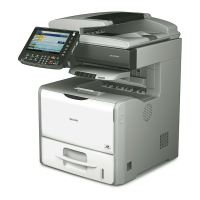The [Accessories] tab contains the following items:
• Prohibit manual destination entry
Check this option to prohibit direct specification of destinations.
• Enable E-mail
Check this when using Internet Fax with the LAN-Fax function.
• IP-Fax
Check this option when using IP-Fax.
After checking this option, select a protocol by clicking an appropriate radio button.
• If the machine's configuration is not configured as instructed, LAN-Fax functions may fail.
• If the machine is connected to a network and SmartDeviceMonitor for Client is installed on your
computer, the machine's configuration will be performed automatically. If the settings do not match
the machine's configuration, click [Load from Device].
Basic Transmission
This section explains how to send fax documents created using Windows applications.
To send a fax, simply select [Print...] from the Windows application, then select [LAN-Fax M14] as the
printer, and then specify a destination in the [LAN-Fax] dialog box.
Open the application document you want to send or create a new document, and then perform the
following procedure.
For details, see LAN-Fax Driver's Help.
• When entering a destination directly or using the destination list of the LAN-Fax to specify a
destination, you cannot specify an e-mail destination and folder destination.
1. On the [File] menu, click [Print...].
2. Select [LAN-Fax M14] in the list.
3. Click [Print].
The LAN-Fax dialog box appears.
The setting method may differ depending on the application you are using. In all cases, select
[LAN-Fax M14] for the printer.
4. Specify the destination.
You can specify the destination using the following methods:
• “Specifying a destination using a destination list”
Sending Fax Documents from Computers
307

